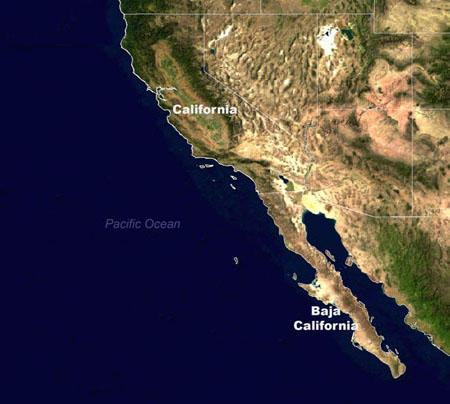|
CAS IN THE CALIFORNIAS
Since the inception of the institution in 1853, research and exploration in the Californias has been an important focus of Academy science. From the northern border with Oregon to the tip of peninsular Baja, Academy researchers past and present have encountered an extraordinarily rich environment for biological discovery. The region includes the California Floristic Province, encompassing the greater part of the state of California and extending into northern Baja. Because of its combination of high endemism and high threat, it is recognized by Conservation International as one of the global biodiversity hotspots deserving priority attention for conservation. California ’s diverse ecosystems include redwood forests, vernal pools, Mediterranean shrublands, montane coniferous forests, and volcanoes, which you can visit in our current exhibit: “California: Hotspot on the edge”, running until Fall 2006. With over 150 years of research and exploration in the Californias, CAS is dedicated to understanding and protecting the region’s unique biological resources and to educating its residents and visitors.
Learn more about the people and institutions involved and our conservation actions in the Californias.
|
 |
People and Institutions
Exploration and collecting by the Academy’s early curators helped to establish our modern biodiversity knowledge of the Californias, which continues to expand today. The specimen collections provide the foundation for widely used print and electronic resources on the biodiversity of California. The Dept. of Botany’s California Wildflowers and Dr. Tom Daniel’s Flora of San Francisco County demonstrate the value of our 500,000+ California botanical specimens. Historical collections data for the reptiles and amphibians of California ’s National Forests were mapped and analyzed together with contemporary surveys by CAS scientists, Jens Vindum and Michelle Koo. Their work revealed changes in the distribution patterns of native and invasive species over the course of a century. Every known species of ant in California can be viewed in high-resolution at AntWeb, a hugely popular and ambitious website spearheaded by Academy entomologist Dr. Brian Fisher and his colleague Dr. Phil Ward at the University of California, Davis. Academy scientists and their colleagues focus on the marine biodiversity of the Californias as well. At the beginning of the millennium, invertebrate zoologist Dr. Richard Mooi and associates in Ichthyology and Education joined efforts with local schools to survey all bottom-dwelling animals of San Francisco Bay in the SF BAY2K project. CBRI mapped results from this survey with historical S.F. Bay collections to see changes in the bay fauna over time. In collaboration with the Conservation Genetics laboratory at U.C. Berkeley, CBRI scientist Dr. Healy Hamilton and Berkeley student Norah Saarman are studying the genetic relationships among Pacific seahorse populations from California to Peru. With a century and half of research and collecting in the Californias, CAS is a resource for all audiences concerned with the present and future of California biodiversity.
Conservation Actions
Although California and Baja are politically and demographically distinct, both regions experience the negative pressures of unsustainable resource extraction, pollution, and habitat degradation due to development. Less than 25% of the original vegetation of the California Floristic Province remains. Biodiversity in the Californias is further threatened by climate change, which is predicted to reduce the water-providing snow packs, produce more extreme climatic events, and lead to a hotter, drier climate. The displacement and extirpation of native biodiversity due to invasive species is yet another threat to the flora and fauna of California and Baja. The Academy’s specimen collections play a significant role in both supporting conservation research and formulating biodiversity management policies in California. The past biodiversity stored in the Academy’s specimen collections is an invaluable, irreproducible record of California plant and animal life, providing a baseline for researchers and managers of what species occurred where in the Californias. Future change can only be measured and understood with respect to a defined baseline against which changes can be compared. Resource managers from public agencies that protect our natural heritage, such as California Dept. of Fish and Game, the Golden Gate National Parks Conservancy, the Marine Mammal Stranding Network, and the USDA Forest Service, rely on the Academy for accurate biological information in support of their mission. The Academy is involved with the conservation and education missions of organizations such as the California Native Plant Society, Baja’s Ocean Oasis project, the Bay Area Science Alliance, and the Point Reyes Bird Observatory. As we rebuild our facility in Golden Gate Park, the oldest scientific institution west of the Mississippi will be prepared to support biodiversity research, conservation, and education in the Californias for many generations to come.
Read about new species described by CAS research in the Californias
|

